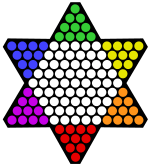Star number

A star number is a centered figurate number that represents a centered hexagram (six-pointed star), such as the one that Chinese checkers is played on.
| 1 | 13 | 37 | ||
|---|---|---|---|---|
The nth star number is given by the formula Sn = 6n(n − 1) + 1. The first 43 star numbers are
1, 13, 37, 73, 121, 181, 253, 337, 433, 541, 661, 793, 937, 1093, 1261, 1441, 1633, 1837, 2053, 2281, 2521, 2773, 3037, 3313, 3601, 3901, 4213, 4537, 4873, 5221, 5581, 5953, 6337, 6733, 7141, 7561, 7993, 8437, 8893, 9361, 9841, 10333, 10837 (sequence A003154 in the OEIS).
The digital root of a star number is always 1 or 4, and progresses in the sequence 1, 4, 1. The last two digits of a star number in base 10 are always 01, 13, 21, 33, 37, 41, 53, 61, 73, 81, or 93.
Unique among the star numbers is 35113, since its prime factors (i.e. 13, 37 and 73) are also consecutive star numbers.
Relationships to other kinds of numbers
Geometrically, the nth star number is made up of a central point and 12 copies of the (n−1)th triangular number — making it numerically equal to the nth centered dodecagonal number, but differently arranged.
Infinitely many star numbers are also triangular numbers, the first four being S1 = 1 = T1, S7 = 253 = T22, S91 = 49141 = T313, and S1261 = 9533161 = T4366 (sequence A156712 in the OEIS).
Infinitely many star numbers are also square numbers, the first four being S1 = 12, S5 = 121 = 112, S45 = 11881 = 1092, and S441 = 1164241 = 10792 (sequence A054318 in the OEIS).
A star prime is a star number that is prime. The first few star primes (sequence A083577 in the OEIS) are 13, 37, 73, 181, 337, 433, 541, 661, 937.
The term "star number" or "stellate number" is occasionally used to refer to octagonal numbers.